Boiler mountings and accessories are required for the proper and satisfactory functioning of the steam boilers.
What are Boiler Mounting and Accessories?
The boiler mountings are fittings that are mounted on the boiler for its proper functioning. Mountings are water level indicators, safety valves, pressure gauges, etc. It may be noted that a boiler cannot function safely without the mountings.
The boiler accessories are the devices, which form an integral part of a boiler but are not mounted on it. They include a superheater, economizer, feed pump, etc. It may be noted the accessories help in controlling and running the boiler efficiently.
Read also: Steam Boilers: Parts, Types, Classification, Advantages, Application, and More
Now let’s discuss different types of boiler mountings and accessories.
Boiler Mountings
Following are the important boiler mountings:
- Water level indicator
- Pressure gauge
- Safety valve
- Stop valve
- Blow off
- Feed check valve
- Fusible plug
Water Level Indicator
It is a main fitting in the boiler, Water level indicator indicates the water level inside the boiler. It is a safety device upon which the safe working of the boiler depends.
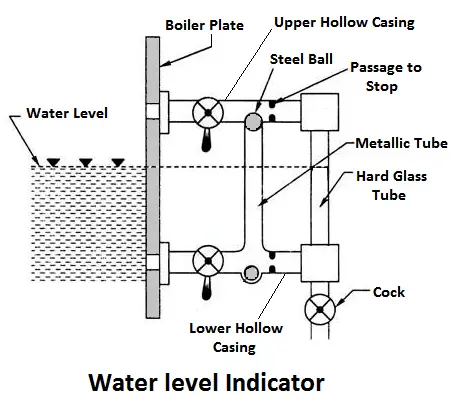
Working Principle
Water-tube indicator the water consists of a vertical hard glass tube G which is fitted with two gunmetal tubes A and B. The tubes A connects the steam space of the boiler with the glass tube and the tube B connects the water space of the boiler with the glass tube.
The tube A is provided with a valve ‘S’, called a steam valve, and tube B is fitted with another valve ‘W’, called a water valve. In addition to these valves, a third valve D, called the drain valve, is fitted to the water level indicator through which water together with condensed steam from the gunmetal tube A is drained from time to time.
Pressure Gauge
Pressure gauges are used to measure the pressure of steam inside a steam boiler. The pressure gauge is fixed in front of a steam boiler.
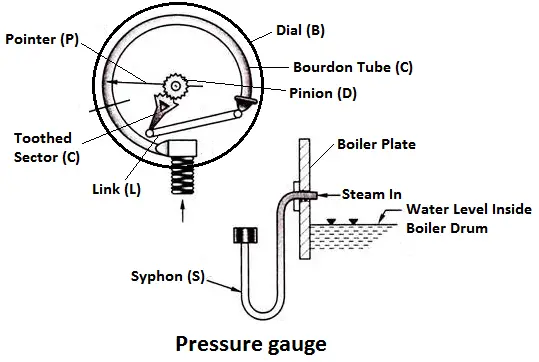
Working Principle
The pressure gauge shown in Fig is a bourdon pressure gauge. It consists of a circular spring tube A. One end of the bourdon tube is closed and connected to a link L and the other end is squared to a Hollow block B.
The link L connects the closed end of the tube to the toothed sector C which is hinged at O. The toothed sector gears with pinion D which carries a pointer P. The pointer moves on a dial graduated in pressure units.
Safety Valves
These are the devices attached to the steam boiler to prevent explosions due to excessive internal pressure of steam.
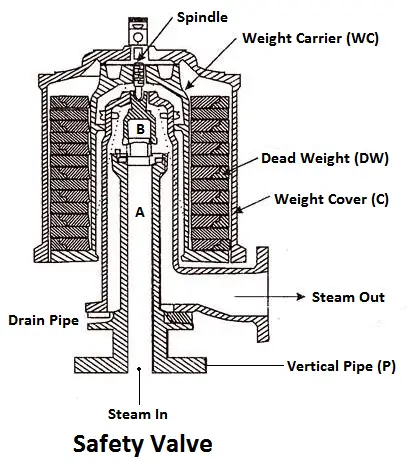
The safety valve is an instrument that prevents the boiler pressure from rising above its normal working pressure by automatically opening when the boiler pressure exceeds the normal working pressure.
Thus, allowing excess steam to escape into the atmosphere until the pressure comes down to its normal valve. Therefore, a safety valve ensures the safety of a boiler from being damaged due to excessive steam pressure.
Read Also: 9 Different Types of Gauge [Working and Uses]
The safety valves commonly used are:
- Deadweight safety valve
- Lever safety valve
- Spring-loaded safety valve
Steam Stop Valve
The function of a stop valve is to control the flow of the steam from within the boiler and to stop it completely when required. A stop valve or junction valve is used to regulate the flow of steam from the boiler.
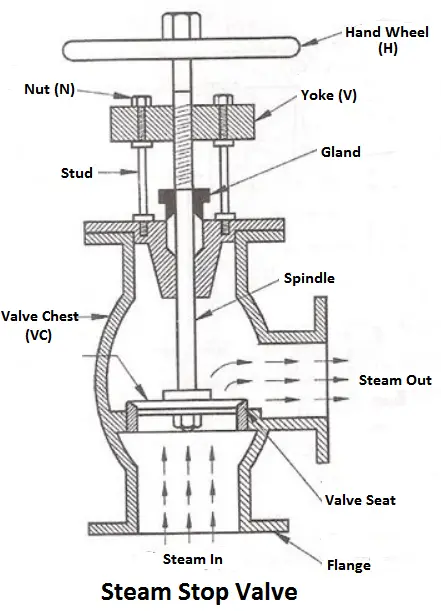
The valves mounted on the boilers, which change the direction of the flow of steam by 90° are called junction valves, while valves fitted in pipelines that allow the steam in the same direction are called stop valves.
Blow-off Valve
The function of a blow-off valve is to remove periodically the sediments deposited at the bottom of the boiler while the boiler is in operation and to empty the boiler while it is being cleaned or inspected.
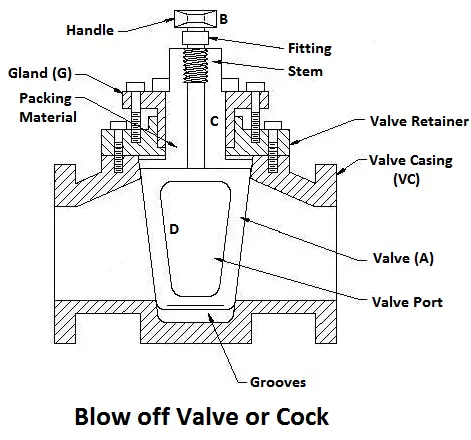
When the blow-off valve is opened the water which is under the pressure of steam, rushes out with tremendous velocity thus carrying out the sediments along with it.
Feed Check Valve
When the level of water in the boiler falls, it is brought back to the specified level by supplying the additional water called feed water.
The pressure inside the boiler will be high therefore the pressure of the feed water has to be raised by a pump before it is fed into the boiler. The feed water under high pressure is fed into the boiler through the feed check valve.
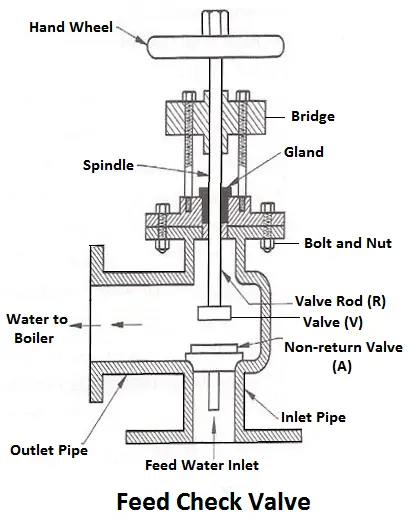
The function of a feed check valve is to control the flow of water from the feed pump to the boiler and to prevent the backflow of water from the boiler to the pump when the pump pressure is less than the pressure or when the feed pump ceases to work. A feed check valve is placed at the boiler end of the delivery pipe of the feed pump.
Fusible Plug
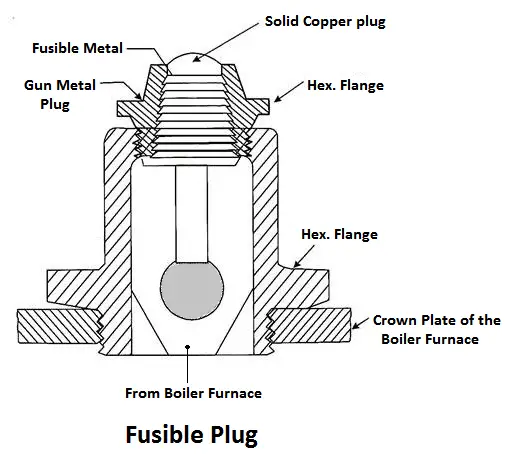
The plug is made up of tin or lead alloy, which has a low melting point. The function of the fusible plug is to put off the fire in the furnace of the boiler when the water level falls below an unsafe level and thus avoid the explosion, which may take place due to overheating of the tubes and the shell. It is fitted over the crown of the furnace or the combustion chamber.
Boiler Accessories
The boiler accessories are required to improve the efficiency of the steam power plant and to enable the proper working of the boiler. The boiler accessories aren’t mounted directly on the boiler.
The essential boiler accessories are:
- Economiser
- Air pre-heater
- Superheater
- Feed pump
- Steam Separator
- Steam trap
Economiser
The combustion gases coming out of the boiler contain a large quantity of heat. Therefore the maximum amount of heat from the gases should be recovered before it escapes to the chimney.
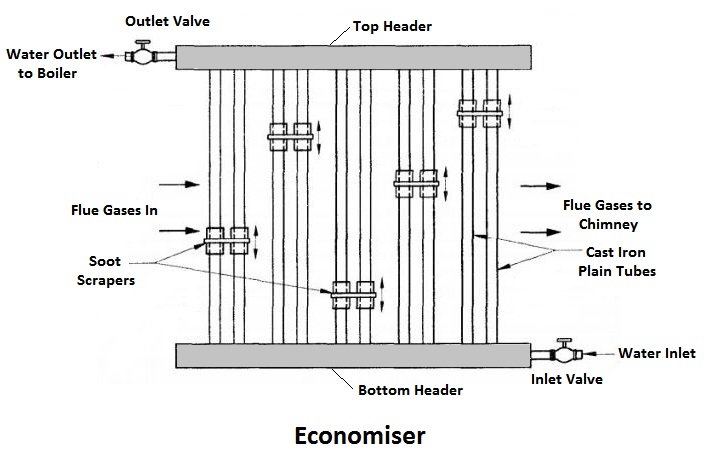
In the economizer, heating the feed water does the recovery of heat in the flue gases. The economizer is placed in the path of the gases. They improve the overall efficiency of the boiler by reducing fuel consumption.
Air Pre-heater
The air preheater is an accessory that recovers the heat in the exhaust gas by heating the air supplied to the furnace of the boiler. Supplying preheated air into the furnace produces a high furnace temperature and accelerates the combustion of the fuel. Thus the thermal efficiency of the plant will be increased.
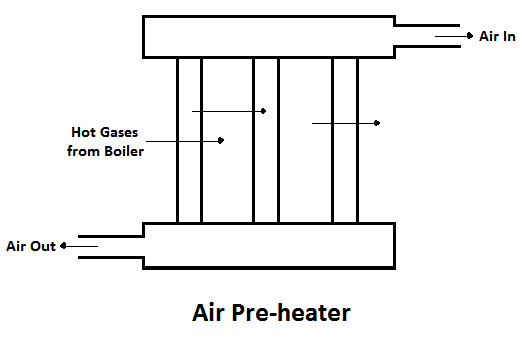
The advantages of air pre-heater are,
- Increase in the steam generation rate.
- Better combustion with less soot, smoke, and ash, and
- Low-grade fuels can be used.
Superheater
The superheater is used in boilers to increase the temperature of the steam above the saturation temperature.
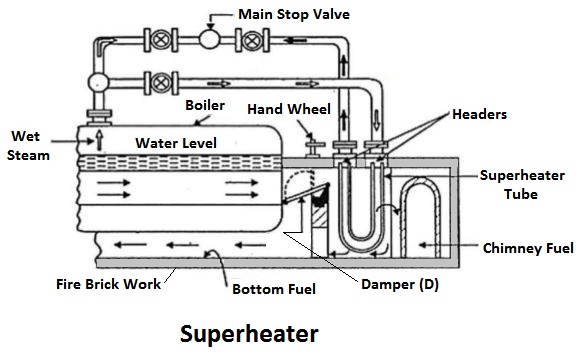
The dry saturated steam generated in the boiler is passed through a set of tubes placed in the path of the flue gases, which will be heated further by the hot gas to increase its temperature about the saturation temperature.
Feed Pump
A feed pump is a boiler accessory required to force the feed water at high pressure into the boiler. Commonly used pumps are,
- Reciprocating pumps
- Rotary pumps
The reciprocating pumps are driven directly by coupling them to the steam engine. The rotary pumps are driven by the steam turbines or by electric motors.
Steam Injector
Steam injectors are used to keep the steam boiler’s feedwater temperatures high and consistent. The handle of the injector is fastened to a shaft at the top. The lower extremity of the valve is responsible for its function.
A screw on the bottom of the spindle fits into a nut, which is a structural component of the steam cone. The movement of the steam cone is also verified by the key. There is a steam pipe, a water pipe for the water inlet, and a delivery cone for where the pressure water exits.
The steam cone swings up and down in response to handle movement, and the valve controls the flow of steam through the steam pipe. The movement of steam governs the flow of water. The water flow creates steam pressure, which controls the sliding movement of the steam cone.
That’s it, thanks for reading. If you have any questions about “Boiler Mountings and Accessories” tell us in the comments, and I’ll respond. If you like this article please share it with your friends.
Subscribe to our newsletter to be notified when we upload new posts. it’s free.
Download the PDF file of this article
Read More:
Send me pdf of mountings and accessories
The PDF file has been sent to your inbox.
Send me pdf of Boiler mountings and auxiliaries
Water tube boiler and fire tube boiler and oil fire boiler full details
The PDF file has been sent to your inbox.
Thanks sir very helpful post
You’re welcome.
Thank you so much. I completed All my assignment thorough your article.
Regards
I’m glad it was helpful for you. You’re welcome. Keep visiting 🙂
Bro can u send me pdf of mountings and acessories of pdf via mail
I sent you the PDF file to your email.